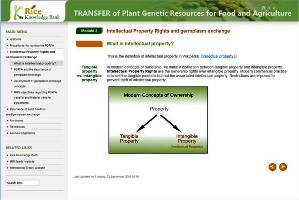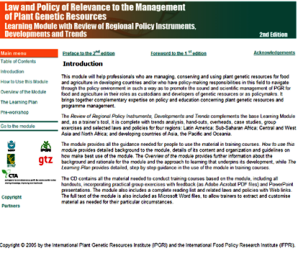Training modules
Pre-breeding for Effective Use of Plant Genetic Resources: E-learning course
 |
This e-learning course was produced by the Global Partnership Initiative for Plant Breeding Capacity Building (GIPB) as part of a comprehensive strategy to develop a critical mass of personnel skilled in the genetic improvement of crops. This course aims at strengthening capacities at the interface between germplasm conservation and its use in plant breeding. The course was jointly sponsored by Bioversity International, Food and Agriculture Organization of the United Nations and the Global Crop Diversity Trust using the GIPB platform.
Pre-breeding refers to all activities designed to identify desirable characteristics and/or genes from unadapted materials that cannot be used directly in breeding populations and to transfer these traits to an intermediate set of materials that breeders can use further in producing new varieties for farmers. It is a necessary first step in the use of diversity arising from wild relatives and other unimproved materials.
Created using the latest digital technology, the interactive, self-paced learning tool covers a range of theoretical and practical topics from the basic concepts and applications of prebreeding to germplasm management to germplasm distribution and regulatory issues.
Every lesson achieves a specific set of learning objectives, using interactive step-by-step instructions and exercises which help reinforce the internalization of the subject matter. The course is complemented by bibliographic references including on-line resources and a glossary of terms. Structured stand-alone Units allow the learner to take the course as a whole or select specific lessons depending on individual needs and circumstances.
The target audience for this e-learning course is primarily germplasm curators and plant breeders and their support and collaborating personnel. University lecturers and students, extension agents, seeds specialists, field technicians and research managers engaged in germplasm management and/or crop improvement will also find this course very useful.
Please access the course here.
Spatial Analysis of Plant Diversity and Distribution
Authors: Scheldeman, Xavier and van Zonneveld, Maarten. 2010. Bioversity International, Rome, Italy. ISBN 978-92-9043-880-9
This training manual is intended for scientists and students who work with biodiversity data and are interested in developing skills to effectively carry out spatial analysis based on (free) GIS applications with a focus on diversity and ecological analyses.
These analyses offer a better understanding of spatial patterns of plant diversity and distribution, helping to improve conservation efforts. The training manual focuses on plants of interest for improving livelihoods (e.g. crops, trees and crop wild relatives) and/or those which are endangered.
Spatial analyses of interspecific and intraspecific diversity are explained using different types of data:
- species presence
- morphological characterization data
- molecular data
Although this training focuses on plant diversity, many of the types of analyses described can also be applied for other organisms such as animals and fungi.
The manual is based on specific exercises, based on real project data. In order to use the manual, you will also need to download the relevant exercise data (listed below). All links below lead to the Bioversity International website.
Download the training manual:
Training Manual on Spatial Analysis of Plant Diversity and Distribution (12 MB)
Download the exercise data as:
A ![]() single file (473.9 MB) (which by unzipping creates the different folders used in the manual)
single file (473.9 MB) (which by unzipping creates the different folders used in the manual)
Or separate zip files for the different exercises:
![]() 2.1 Importing observation data (103 KB)
2.1 Importing observation data (103 KB)
![]() 2.2 Importing climate data (258.2 MB)
2.2 Importing climate data (258.2 MB)
![]() 3.1 Basic elements (121.7 MB)
3.1 Basic elements (121.7 MB)
![]() 3.2 Export to Google Earth (1.0 MB)
3.2 Export to Google Earth (1.0 MB)
![]() 4.1 Quality control – Administrative units (13.6 MB)
4.1 Quality control – Administrative units (13.6 MB)
![]() 4.2 Quality control – Atypical points (3.9 MB)
4.2 Quality control – Atypical points (3.9 MB)
![]() 5.1 Species diversity (4.0 MB)
5.1 Species diversity (4.0 MB)
![]() 5.2 Diversity - Phenotypic data (8.4 MB)
5.2 Diversity - Phenotypic data (8.4 MB)
![]() 5.3 Diversity - Molecular marker data (4.0 MB)
5.3 Diversity - Molecular marker data (4.0 MB)
![]() 5.4 Conservation strategies (6.8 MB)
5.4 Conservation strategies (6.8 MB)
![]() 6.1 Realized niche (12 KB)
6.1 Realized niche (12 KB)
![]() 6.2 Potential distribution (9.8 MB)
6.2 Potential distribution (9.8 MB)
![]() 6.3 Climate change (29.7 MB)
6.3 Climate change (29.7 MB)
![]() 6.4 Gap analysis (12.7 MB)
6.4 Gap analysis (12.7 MB)
See also additional resources related to this topic: Mapping the ecogeographic distribution of biodiversity and GIS tools for plant germplasm collectors
Transfer of Plant Genetic Resources for Food and Agriculture
|
|
Transfer of plant genetic resources online course
(External link to IRRI's website)
This training module is an online self-study course on the transfer of plant genetic resources for food and agriculture. This course is developed by IRRI and has also been incorporated in the Rice Knowledgebank.
This course is recommended for anyone who wishes to send, receive or carry plant genetic resources for food and agriculture from one place to another and to better understand the intellectual property rights and phytosanitary issues involved when moving germplasm. (In this case, rice to or from IRRI.) It aims to avoid breaches of legislation when Plant Genetic Resources for Food and Agriculture (PGRFA) is exchanged.
The course contains the following modules:
- Procedures for moving rice PGRFA
- Intellectual Property Rights and PGRFA Exchange
- Importance of Seed Health in PGRFA Exchange
The modules can be studied independently and in any order.
Procedures for moving PGRFA is a set of steps that you must follow to ensure problem-free movement of rice plant genetic resources for food and agriculture. This module deals ONLY with cases where PGRFA movement involves a transfer of intellectual property rights. Intellectual Property Rights and PGRFA movement and Importance of Seed Health in PGRFA movement are information-based. They provide some basic background information on intellectual property and phytosanitary issues.
The International Treaty on Plant Genetic Resources for Food and Agriculture
|
Available in English, Français, Español |
Learning module on the International Treaty on Plant Genetic Resources for Food and Agriculture
(External link to Bioversity's website)
The aim of this learning module is to develop knowledge and skills to implement the International Treaty on Plant Genetic Resources for Food and Agriculture and to use The Treaty’s standard material transfer agreement (SMTA).
The module, availabel in English, French and Spanish, contains practical exercises to reinforce an understanding of the impact and working of International Treaty law in the types of situations that professionals in plant genetic resources can expect to face. It also includes background lecture notes, PowerPoint presentations, references to relevant laws and policies with links to the documents and a bibliography for further reading.
While designed for a 2-day workshop, the materials can also be used separately to support classroom teaching.
This module updates and replaces the session on the International Treaty in the 2005 training module on Law and Policy of Relevance to the Management of Plant Genetic Resources
The learning module is also available on CD. If you wish a copy for personal use or for use in education or training workshops, please contact Ewa Hermanowicz (This email address is being protected from spambots. You need JavaScript enabled to view it.).
You can find some videos and a slideshow about the ITPGRFA here.
Law and Policy of Relevance to the Management of Plant Genetic Resources
|
|
Learning Module with Review of Regional Policy Instruments, Developments and Trends
(External link to Bioversity's website)
This module will help professionals who are managing, conserving and using plant genetic resources for food and agriculture in developing countries and/or who have policy-making responsibilities in this field to navigate through the policy environment in such a way as to promote the sound and scientific management of PGR for food and agriculture in their roles as custodians and developers of genetic resources or as policymakers. It brings together complementary expertise on policy and education concerning plant genetic resources and programme management.
The Review of Regional Policy Instruments, Developments and Trends complements the base Learning Module and, as a trainer's tool, it is complete with trends analysis, hand-outs, overheads, case studies, group exercises and selected laws and policies for four regions: Latin America; Sub-Saharan Africa; Central and West Asia and North Africa; and developing countries of Asia, the Pacific and Oceania.
Click here for the new (2010) version of the training module on the International Treaty and the Standard Material Transfer Agreement which replaces Session 5 of this policy training module.








